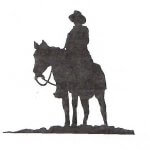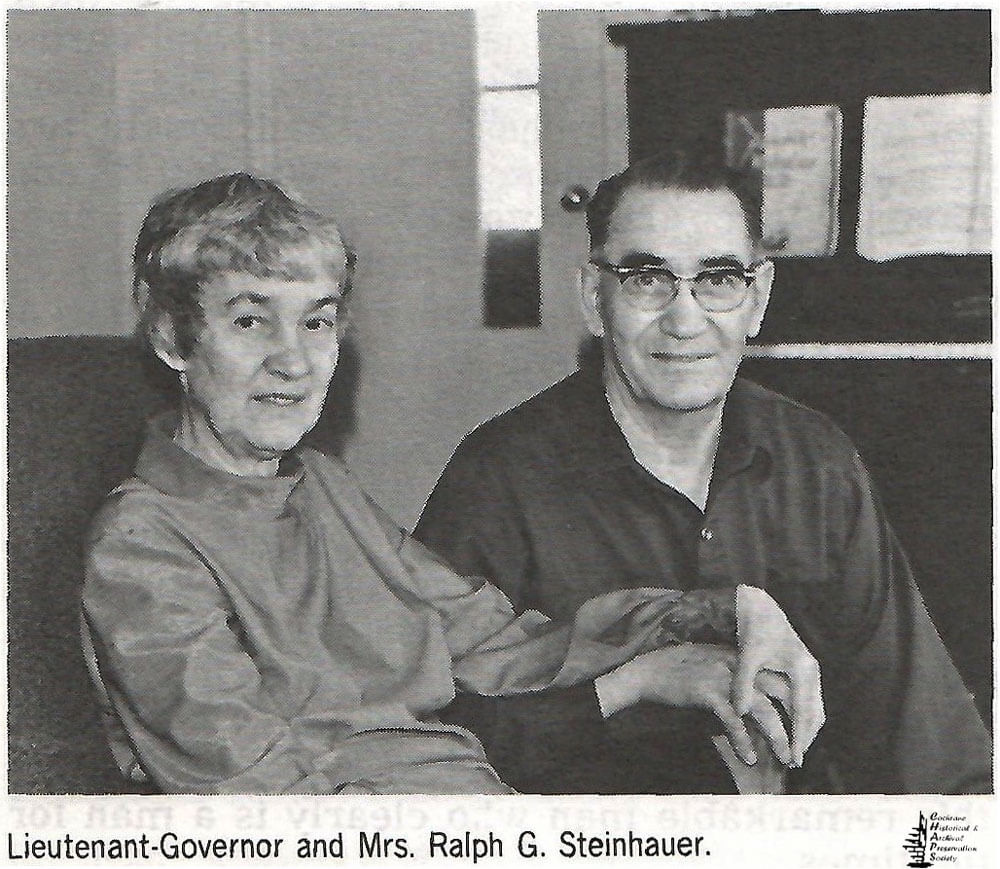by Mary B. Mark pg 95 Big Hill Country 1977
Dominion Day, 1974, has a special significance and one with many satisfactions for the citizens of Alberta, marking as it does the first day in office of the new Lieutenant Governor, the Honourable Ralph Garvin Steinhauer. His appointment has proven a stimulating and happy choice for Albertans.
Ralph Garvin Steinhauer was born on the Morley Indian Reserve on June 8th, 1905, the year Alberta became a province. He lived also at Brocket and in residence at the Red Deer Indian Industrial School for his primary grades. Early memories are centred around his life on the Saddle Lake Indian Reserve where his father, James Steinhauer, had come with family and friends to establish a new community. Their home was built on that part of the nineteen and one-half sections of the reserve later purchased from the native farmers by enterprising white men.
The Steinhauer family, greatly influenced by the life and teachings of their grandfather, the Ojibway missionary, Henry Steinhauer, knew the value of education and the benefits of agricultural practices. James Steinhauer, however, had no mind to send his children away to the residential schools. They must attend Doucet School, a public school where mostly French was spoken, a good six-mile hike from home. Ralph Steinhauer and his sister Winnifred were the only two children from the reserve to attempt this integrated type of schooling. (At first, they were given a bad time by the other children but soon they were accepted.)
Mr. Steinhauer recalls: “Later we went to Roseneath School, south of Ashmont, again the only two children from the reserve. We had a regular League of Nations there – a good teacher, good discipline. I liked history and geography best of my studies, and we had outdoor sports – lots of fun.
“My father, who also acted as interpreter on the reserve and did a lot of carpentry work, had established quite a farm by this time. We children had our share of chores to do. After threshing in the fall, we had the long haul to bring grain to the elevator at Two Hills. At 18 I was one of the first members of the Alberta Wheat Pool.” He proudly shows the leather plaque presented to him as a founding member.

Another vivid memory is the arrival of the railway to Ashmont in 1919 and to St. Paul in 1921. He recalls when many acres of the reserve land were sold.
“I was about 20 when white buyers came with many ten-dollar bills in their pockets. I didn’t like to see the land sold. I told my elders that it would be a great loss to my generation, but because I was not 21 they didn’t allow me to speak at the meeting.”
Many a moccasin mile he pondered, knowing full well the land was worth much more than the paltry sums paid.
The next year after threshing he found winter employment in the General Store and Post Office at Vilna. It was there he met Miss Isabel Davidson, the soft-spoken and lovely schoolteacher.
“I didn’t see him until late in November,” Mrs. Steinhauer says with a laugh. They skip lightly over this time, but it was a romance, a love match. To be brought “home” to the reserve, to live the first summer in a tent, cook in a granary, to help with the building of the first log home, are happy memories today. Many pioneers can share such memories with them … the frogs chorusing in the nearby slough in the evenings, the fresh spruce-scented air, the strawberries and other wild fruit, fried partridge, roast duck … making tea, making lunches, suppers . . . summer at Saddle Lake. The young teacher, born in Buffalo, New York, who had come west to Edmonton at the age of 15 with her widowed Scottish mother, would wonder and marvel.
“It took me a little while to get used to being a farmer’s wife,” Isabel Steinhauer says, “But I finally adapted.” She had become a teacher after taking business training at McDougall Commercial College in Edmonton.
“Mr. Percy Page was my teacher. I worked as a bank teller at Provost for a couple of years and then went to Normal School. I taught school at Vilna, and I loved it, but Ralph wanted to farm, make our home here. It has been a good life, a busy life – a real home.” Mrs. Steinhauer states simply the sum of their 47 years of married life.
.
I taught school at Vilna, and I loved it, but Ralph wanted to farm, make our home here. It has been a good life, a busy life - a real home.”
Isabel Steinhauer Tweet
From the beginning, the young couple had much to do. There were people to meet, to understand. The Steinhauer family had several branches, notably Uncle Robert who maintained the Mission Church located at the far end of the reserve. For Ralph and Isabel, it meant a 13 mile trip in a lumber wagon when weather permitted. Also when weather permitted, Ralph coached his baseball team.
In 1929 their daughter Muriel was born and a year later, Doreen. The birth of Kay, in 1932, came at the end of a sports day in St. Paul, when Ralph’s Saddle Lake baseball team won the day. “It was a great day,” Ralph remembers, “Win ning the ball games – and another beautiful daughter at night!”.
At 25, Ralph Steinhauer was increasingly concerned and affected by the problems that affected the reserve. Without adequate fences, stray cattle pastured on the reserve and their own cattle often became lost. Too, the farm advisor provided by the government was a man who didn’t know a neck yoke from a singletree, or anything about the handling of livestock.”
A native person wishing to speak to the Indian Agent had to talk to him through a wicket. If the agent didn’t like the discussion or if he thought it went on too long, he shut the wicket down in the face of the speaker. Also at that time, the Indian Agent did not meet with the native band councillors. Chief Moses acted as the go-between in those early years. Progress and communication did not exist.
After much frustration, Ralph decided to call a council meeting. The councillors came to the waiting room. “We’re here to have a meeting,” he told the Indian Agent. “We want you out here with us.” Each band member had his say. They wanted regular meetings and open discussion of problems with the Indian Agent. Maybe this could be arranged.
“The council meetings were the beginning of change. People began to take an interest in their own affairs. A new Indian Agent came, Mr. Bill Pugh. He brought more changes. He welcomed the council meetings, had the councillors in for lunch!”
(The Indians had to have a permit to sell a load of grain or a calf. Through the efforts of Ralph Steinhauer, this was changed and permits are no longer in use.)
The little girls were now well past school age. With no day school on the reserve, Isabel Steinhauer had to send her children away to the residential school at St. Albert. This went on for three unsatisfactory school terms. Not at all pleased with the quality of education, her children were receiving, Mrs. Steinhauer applied to the Correspondence School Branch and taught the children at home. Later the girls were registered in the Duclos Mission School at Bonnyville and went on to complete their education in their chosen fields of teaching and nursing. In 1937, the fourth daughter, June, was born, and in 1945, their son Kenneth arrived. B this time a day school had been built on the reserve, taught by Catholic sisters.
The years have been filled with active community work both on and off the reserve. Neighbours and friends have always found a warm welcome in the Steinhauer home, built close to the highway in the corner of their 1800 acre farm, where cattle and grain crops are raised.
Ralph Steinhauer’s work with the band council, begun in 1932, was to continue for 37 years. Three of these years were served as Chief. Active for many years in the work of the Indian Association of Alberta, he travelled the province, a well-known and respected figure. Later he sat on the board of the Alberta New Start Program and in 1971 the Alberta Indian Development Systems Limited. For his valuable contributions to Indian and agricultural organizations and his community, Ralph Steinhauer was invested with the Order of Canada in 1967 and made an Officer of the Order in 1972.
Remarking on the progress and changes over the years, Mr. Steinhauer notes the population of the Saddle Lake Band is now 1600. There is a library, a playground, a kindergarten and a day school with seven grades, with Cree teacher aides helping the youngsters. There are sports facilities for the active young people, and graduating students may choose to go to the Blue Quills Residential School, now programmed and staffed by the native people, or to surrounding schools.
“We are just as much a part of the farming community of Brosseau — all are friends and neighbours,” Mr. Steinhauer added. “We’ve known each other and worked on projects together for many years now.”
Their family now includes 16 grandchildren and one great-grandchild. Messages from the grandchildren, bursting with pride in their grandfather, have come as posters and cards, carefully written and decorated. The hand-carved sandalwood chest they had bought two years before in Zanzibar is filled with letters and cards all bearing good wishes and congratulations from friends near and far.
Bit by bit the pattern emerges, the pattern of the past that has shaped the present and the future and made Ralph Garvin Steinhauer the first native Canadian to become the Lieutenant Governor of his province. The story is one of heritage and destiny, courage, intelligence and far-sightedness; and the great good humour and wisdom of this kindly and generous-hearted man who now becomes a historical figure in Alberta.
Beside him, his wife Isabel gives her whole-hearted and loyal support to every decision of this remarkable man who clearly is a man for the times.



